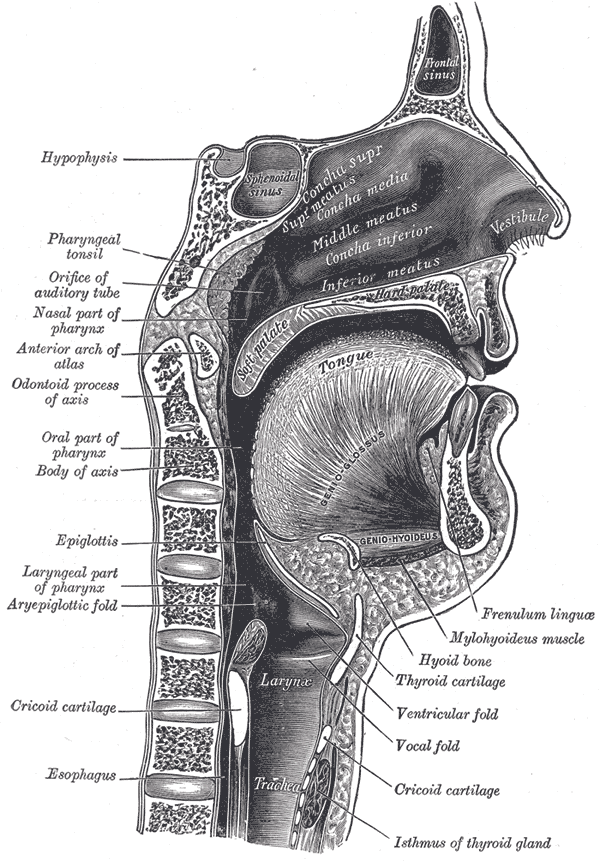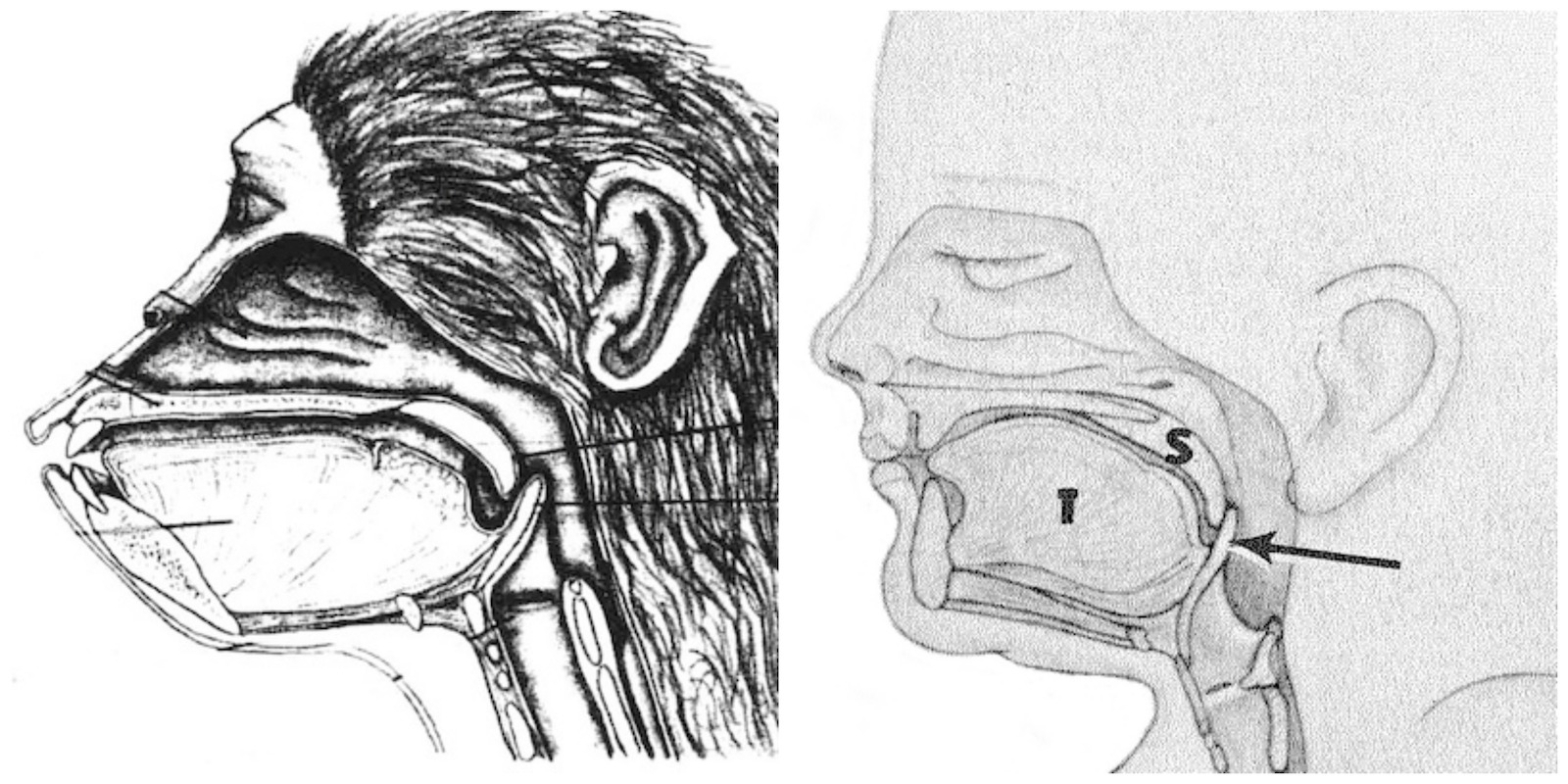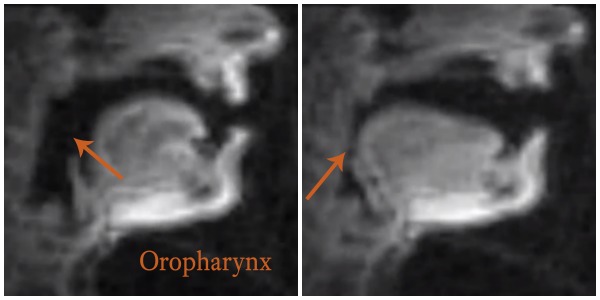Why do we need a tongue?
The tongue is a multi-purpose organ involved in aspects of the alimentary and respiratory systems, as well as having a crucial role in communication. I will primarily focus on the tongue’s role in the production of language sounds. However, I think it’s worth taking a quick glance at some of its other functions.
Alimentary System
- The tongue is the site of the majority of our taste buds, which enable us to sense sweet, sour, salty, bitter, and umami tastes. Taste is an important tool for testing food safety.
- For solid foods, the tongue acts as the spoon in the bowl of the mouth, both mixing food with saliva, and working with the insides of the cheeks to push food toward the teeth. We also use the tongue to clean the teeth, capturing stray bits of food that may have gotten caught in their nooks and crannies.
- For babies, the tongue is very important in suckling.
- The tongue helps push food, liquid, and saliva back towards the throat for swallowing. It pushes up against the roof of the mouth when we swallow.
Respiratory System
- When the mouth is open, we can raise the back of the tongue against the soft palate to close the mouth off from respiration and channel the breath through the nose.
Communication and Bonding
- If you’ve ever stuck your tongue out at someone, you’ve used it for non-verbal communication.
- Kissing! With tongue! Enough said!
- While the basic vibration that enables speech is produced in the trachea at the vocal folds (also sometimes called the vocal cords), the vast majority of distinct sounds that make up speech – consonants and vowels – are produced in the pharynx and oral cavity, shaped by the interior walls of these spaces, and by the tongue.
Vocal Tract Anatomy and Evolution

Some things to note:
- The soft palate can lift and close off the opening between the nasal and oral parts of the pharynx. This happens when we swallow, to prevent food and/or liquid from going up the nose. Hopefully, nobody makes you laugh, right as you’re trying to swallow.
- In adults, the tongue is positioned so that it lies both in the floor of the mouth, and forms the anterior (front) wall of the oropharynx. This arrangement is unique among mammals, and enables the wide range of distinct vowel and consonant sounds necessary for language.
In other mammals, and in human infants, the larynx is positioned higher, with less distance between the uvula of the soft palate and the epiglottis. These two structures can lock together, which is why babies can swallow and breathe at the same time when they’re nursing. In humans, the larynx drops over the first six years of life. A note from the voice studio – most children are not able to reliably carry a tune unaccompanied until they’re about six or seven. (There are, of course, exceptions.)

There are disadvantages to the lowered larynx in the human adult, the primary one being the choking hazard that comes with the crossing of the airway and the food way in the oropharyx. There is also speculation that Sudden Infant Death Syndrome (SIDS) is caused by mismatched signals as babies transition from a neurological and physical stage of breathing primarily through the nose (what is referred to as obligate nose breathing) to volitional mouth breathing. Language clearly had enough of an evolutionary advantage to offset these downsides of the lowered larynx.
Tongue Tension
Excessive tongue tension is common. It can be related to posture issues, or linked to tension in other areas of the body. In can also be tied to feelings of being unvoiced in one way or another: you can’t think of the right words to say; someone interrupts you or shuts you up or just won’t listen.
Emotions also have associated physical movements, and many of these movements are felt strongly in the area of the vocal tract. If you’ve ever had the experience of having to speak or sing while trying not to cry, you’ve probably experienced some associated tongue tension!
Because the muscles of the tongue attach to the hyoid bone, which in turn has muscular and fascial connections to the larynx, a tense tongue can effectively pull on the larynx, making the movement necessary for phonation more difficult and contributing to vocal fatigue. Vocal fatigue, such as hoarseness or loss of voice can effect anyone in a high-use situation, such as teaching.
Even if you are not making yourself hoarse, a tense tongue will produce tense sounding language. Just as we can react with a kind of sympathetic tension when we walk around in a world of people with their shoulders up around their ears, we often tense our bodies in response to tense sounding phonation. Becoming aware of tongue tension and learning to release it can help us avoid passing this tension, through unconscious modeling, to our students. (I am reminded of this Franklin Method aphorism: You’re not teaching your actions, you’re teaching your state of being.)
Imagery Activities to Relax the Tongue
- Melting Swallow. Line up the tips of your fingers vertically along the midline on the front of your throat, over the larynx and hyoid bone. Swallow. You’ll feel your larynx move up, and then back down again. Swallow again, and as the swallow releases, imagine the larynx melting down into the thorax.
- Flow. Imagine your tongue is liquid. You can think of it as a river, flowing unidirectionally towards the front of your mouth. Or you can think of a meandering flow with whirls and eddies. You can think of a liquid that is more viscous, like honey. If you’ve ever seen a slow moving tongue of lava, you can think of your tongue as molten lava, slowly spreading out in the bottom of your mouth.
Movement of the Tongue in Language
The principle areas of the vocal tract for language sounds are the oropharynx, where most vowel resonance is created; the oral cavity, where most consonant sounds are created; and the nasopharynx, where resonance is channeled when we say nasal consonants, such as [m], [n], and [ŋ].
A Tongue Tour of Some English Consonant Sounds in the Mouth
IPA Consonant Cheat Sheet
[d] as in did the
[dʒ] as in junior
[k] as in kitty cat
[l] as in love the
[m] as in monstrous maufrey of
[n] as in nine nannies in the
[ɲ] as in canyon,
[ŋ] as in singing with
[s] as in certainty:
[ʃ] as in “shush, little kitty, or no
[t] as in teatime treats for you; no
[tʃ] as in tchotchkes to take home to
[ð] as in the little ones;
[θ] as in nothing to make you
[z]as in sizzle.”
-
Slowly say the words the thing. Notice that to make the th sound, you place the top of your tongue against the bottom of your upper front teeth, and let your breath flow through this very compressed space. Try saying just the th of the. Then try saying just the th sound of thing. Even though you’re placing your tongue in the same position for both consonants, they are different. The th sound of the is what we call a voiced consonant. The th of thing is unvoiced. If you put your finger tips on the front of your larynx and speak the voiced and unvoiced versions of th, you’ll be able to feel the vibration in the larynx during the voiced consonant.
One of the challenges of writing about language, is the problem of having sounds that look the same in written form, and yet are different in their spoken form. Anyone who has had to learn English as a second language is no doubt familiar with this problem. Happily, linguists have developed a specialized alphabet with unique symbols for every possible language sound in the world. It’s called the International Phonetic Alphabet (IPA), and is useful to anyone who needs a reliable, standardized reference for correct pronunciation of any word in any language. The symbols for the voiced and unvoiced th sound are [ð] and [θ] respectively. Use of IPA symbols are indicated by the square brackets.
Consonant sounds made here, between the tongue and teeth, are referred to as dental.
-
Place the tip of your tongue against the back of your upper front teeth. Slowly move the tip of your tongue back (posteriorly) along the roof of your mouth. Behind the teeth, you’ll feel a series of ridges before the roof of the mouth domes upward to the hard palate. This is the alveolar ridge. Make the following English consonant sounds, and notice how the tongue is positioned during these sounds relative to this ridge: [t], [d], [s], [z], [n], [l], [tʃ], [dʒ].
Consonant sounds made here, unsurprisingly, are referred to as alveolar.
-
Behind (posterior to) the alveolar ridge, the roof of the mouth domes upwards, and you can feel a bony surface under the mucosal layer. This is the hard palate. Try saying the [ɲ] sound of canyon
You can also try an American [r], for instance, slowly saying the word rear and noticing how the tip of your tongue moves in relation to the hard palate. For those of you who are speaking English as a second language, or who are not speaking an American English dialect, I will describe the movement. The tip of the tongue is pointed upward, towards the hard palate, and curled a little bit back towards the soft palate. The tip approximates the hard palate without touching it. This position is called retroflexive.
-
Continue to move your tongue back toward your throat. You should be able to feel, with the tip of your tongue, the end of the hard palate, and beginning of the soft palate. In the world of phonetics, this is also called the velum. Try making the English consonant sounds [k], [g], and [ŋ]. The back of the tongue comes up against the soft palate to make these sounds.
Vowel Sounds and the Oropharynx
The oropharynx is the primary area of resonance for the vowel sounds in language. The movement of the tongue makes dramatic changes in the shape of this space, and it is these changes which give us such a wide range of vowel sounds (between 14 and 20 in English, depending on your dialect).
To try out a few, speak the following sequence, developed by the linguist Peter Ladefoged (Elements of Acoustic Phonetics, 1962):
heed, hid, head, had, hod, hawed, hood, who’d
Let’s simplify the task by looking at just two vowels, [i] as in tree (on the left) and [a] as in father (on the right). Note the widening, in the sagittal plane, of the oropharynx during the articulation of the [i] vowel. In the [a] vowel, the part of the tongue that forms the anterior wall of the oropharynx moves back toward the spine.
Below is another view of the same two vowels. These images are taken from a short film called The Diva and the Emcee, made by the the good folks at the Speech Production and Articulation Knowledge Group at the University of Southern California School of Engineering. The films shows a real-time MRI of the vocal tracts of two singers, one trained in a European classical tradition, and the other a beat boxer. These stills show the classical singer’s tongue position as she sings Puccini’s “O mio babbino caro”; on the left, the [i] of mio; on the right, the [a] of caro.
Developing a Sense of the Oropharynx
It can be difficult to develop a proprioceptive sense of the oropharynx. It is, after all, an open space; a negative space our body curls around; one we can’t easily see, and which we must then try and image.
- Following the path of the breath.Breathe silently through the nose. Picture the air as it goes through your nasal passages into your nasopharyx, and then descends into the oropharyx and into the trachea. You can draw the path of the air on the side of your face and neck to help visualize its passage.
- ng hum. Hum quietly on an ng sound (IPA symbol is [ŋ] as in hangup). See if you can sense vibration in the oropharynx.
- [ŋ] — [a] sequence. Sing, or speak-sing (continuous phonation) the [ŋ] and [a] sounds in sequence, sensing the movement of the tongue at the back of the mouth and in the oropharynx.
- Modeling the movement of the back of the tongue with the hands. Hold one hand vertically (fingers pointing up) to represent the back wall of the throat. Hold the other hand horizontally in front to represent the part of the tongue that forms the anterior wall of the oropharynx. Sing, or speak-sing between the [i] and [a] vowels. The tongue hand moves back toward the throat wall hand for the [a] vowel, and foward, increasing the distance between the two hands for the [i] vowel. Move your hands in coordination with your vocalizations.
Putting it All Together: Language and Tongue Flow Imagery
- Return to the flow imagery used above: Imagine your tongue is liquid. Think of it as a river, flowing unidirectionally towards the front of your mouth, or as a meandering flow with whirls and eddies. Can you maintain this image, while slowly moving back and forth between the [i] and [a] vowels, either singing on a comfortable pitch, or speak-singing.
- What happens if you add consonant sounds to these vowel sequences? Can you maintain a feeling of flow in the tongue while singing or speak-singing: tree tops; peat moss; green box.
- Try and combine the feeling of flow in the tongue while you experiment with other vowel and consonant sounds. Are some sounds more difficult than others?
- Find something to read aloud, and see if you can maintain a sense of flow in the tongue while you’re reading. See what happens if you read faster, or even as fast as you can. You can also listen to the radio or tv and repeat what is being said as you hear it, and see if you can maintain this sense of flow.
- If you are multi-lingual, try this activity in different languages.

